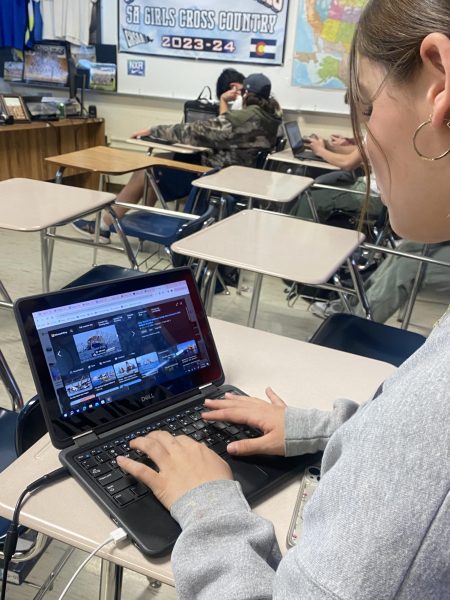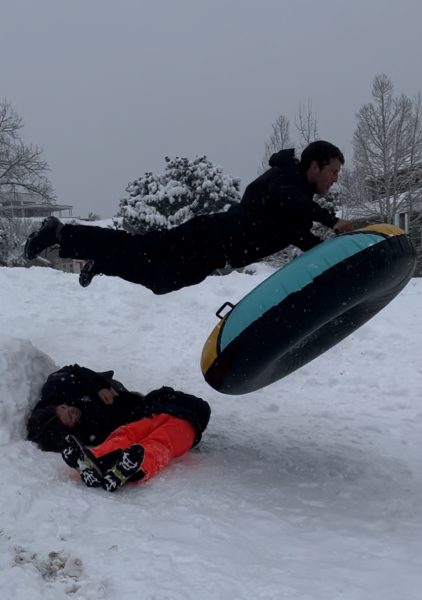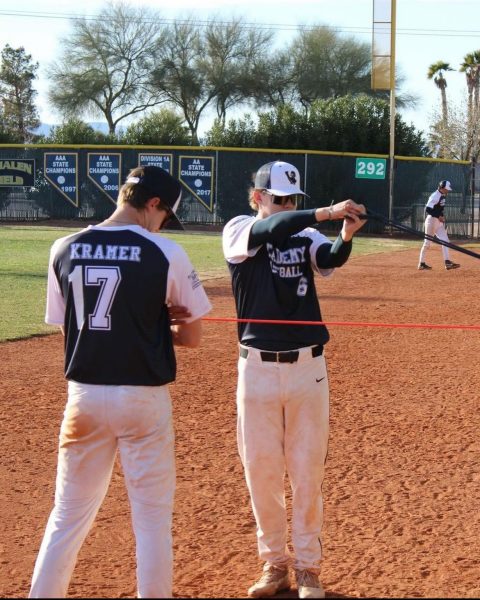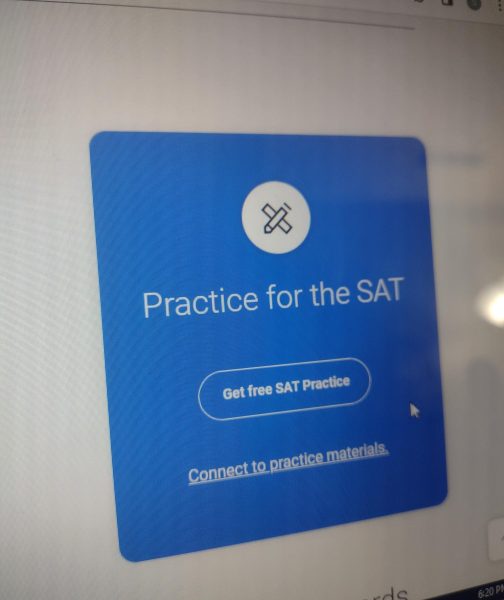100 Tips For Swimming Success
Hiya! I’m Mida and I have been swimming for a grand total of 12 years and have been a part of the Air Academy High School swim team for all four years. In my years of experience, I have picked up several tips and tricks that I wish I knew when I was starting out. I learned that swimming can be a very difficult sport both mentally and physically, so I’m glad to be sharing these tips with whoever might be interested in starting swimming.
Howdy to you from Alex! My swimming career started when I was 7; I dove right into competitive, year-round club swimming. Being a junior, I have two years of high school swim experience under my belt, and I am excited for my third year this spring. Like Mida, I too have acquired a decent knowledge of the sport in many aspects, though not nearly as much as the wonderful coaches I have had through the years. I love the sport; it essentially has defined me and made me the person I am and will be. I have hopes to share a taste of the knowledge that has been both passed on to me and that I learned for myself with the readers of this compilation. Happy swimming!
- The saying that “You need to wait 30 minutes after eating to swim” is a bogus wives’ tale. It’s not necessarily about when you eat, but more about what you eat. Know your stomach and know your body; being aware of what is best for you is important.
- You may not feel thirsty while you swim but bring water anyway. Hydrate or die-drate.
- An insider from Alex: Swim downhill, swim like you’re eight feet tall and watch your breathing pattern to maximize your stroke economy. Smooth, assertive, pretty, and stern is the name of the game.
- Instead of pulling with your arms to catch the water, think more of sticking your arms in the water and moving your body past them. Minimal slip is the idea.
- Knowing the layers of the pool water can be very helpful: the surface is the first 4 inches, you want your body to be as close to this as possible for optimal speed. The “v” layer (the next 12-18 inches below the surface layer) is where you want your kick, pull and the end of your streamline to be for optimal speed. The concrete layer (24″ from the surface and on down) is where the start of your streamline should be. The farther down you go, the denser the water gets, making it harder to go fast. These words of wisdom were given by AAHS Swim Coach Scott Newell, and when put into practice this principle gives immediate results (if you have a true feel for the water).
- Dolphin kicks start at the top of your abdominal muscles and pulses or flicks down the rest of the body to the feet in a snappy fashion like a dolphin’s motion. The common misunderstanding is that the kick is one-sided, only the down direction. For the most effective kick, you flick your body back and forth like a bell hits both sides to ring.
- Long axis strokes are freestyle and backstroke as your hips, head and shoulders rotate on the axis of your spine. Short axis strokes are breaststroke and butterfly because your body moves up and down about the central point of your hips.
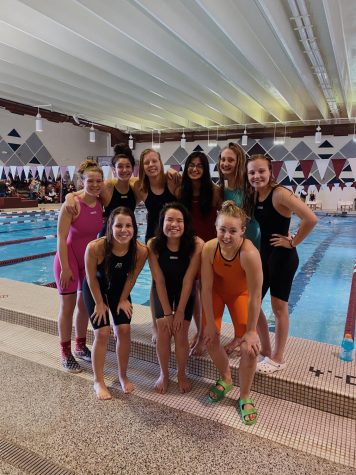
A few members of the AAHS girls’ swim team pose in their tech suits in front of the Cheyenne Mountain High School pool during the regional championships. - For freestyle, taking a breath means that your head rotates about a central axis that is essentially your neck and spine, not lifting your head up and sideways.
- On freestyle sprint events, have a shoulder driven freestyle; move the hips less and rotate less so that maximum tempo can be achieved. For long-distance freestyle, rotate your body no more than 30 degrees right to left in order to grab as much water as possible.
- Don’t forget to tuck your chin on all strokes, except backstroke, put your chin back.
- For freestyle, proper kick tempo is crucial. A “4 beat kick” means that in the duration of two strokes (a stroke cycle) your legs kick up and down fully 4 times [2 each leg], a “6 beat kick” and “8” beat kick are the same theory. When sprinting just let it rip, don’t count.
- When breathing on Freestyle and butterfly, your head does not follow your arms when breathing, it moves faster. It’s awkward at first but the timing will become natural.
- Streamlines are when your arms are above your head, behind your ears and hands are locked. This is used off of starts and turns, and they make a big difference in races.
- Flip turns are your friend, they make you go faster and make your race more fluid.
- To have a good open turn (used in all circumstances that flip turns are not used), a quick-touch-and-go mindset is most advantageous.
- Important tip from Mida: the greater controlled acceleration off of the starting block, the less likely goggle failure is and the better the start. Pulling off the front of the block with arms is equally as important as the leg portion. The leading leg’s shin (the one offset and put forward with toes hanging over the edge; its the last thing to leave the block) should be parallel to the water’s surface before it leaves.
- Taking time off an event, no matter how minimal, is always a good thing.
- To go to the State Meet or a faster meet than that, a certain time for an event needs to be attained.
- Whether an ASD20 pool or any other competition pool, the water is cold, but not that cold. Tensing up when getting in the water doesn’t help. Unfortunately, the only way to get over the cold is to stay loose, let it sink into your bones and then warm up afterward.
- “Sculling” is a drill that helps a swimmer get a “feel” for the water. The most common iteration of this drill is to keep hips up at the surface and sweep arms back and forth, grabbing water with forearms, and propelling forward smoothly.
- IF YOU ARE GOING TO ANNOUNCE EVENTS AND DIVING AT A SWIM MEET: KNOW WELL WHAT YOU’RE DOING BEFORE YOU MAKE A FOOL OF YOURSELF (I [Alex] learned this the hard way and it was the most embarrassing night of my life) (p.s from Mida: I saw it all and still make fun of Alex for it.)
- Getting out of the pool to go to the bathroom in the middle of a set is disrespectful to your team.
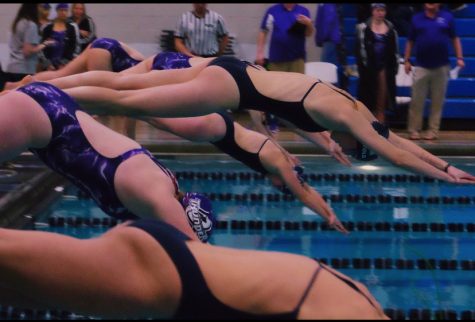
AAHS girls’ swim team dive into their race on the January 29th meet against Discovery Canyon High School. Photo credit to Elizabeth Dalton. - You spend every day with your teammates at practice, so it’s more fun if you get to know them.
- When you have a rough practice, shower time or hot tub time with friends is redeeming.
- Laughing with your teammates until your stomach hurts and you can’t breathe can create a circumstance where trained swimmers fear drowning due to loss of motor skills.
- Your teammates will ask for help if they need it; don’t be a technique critic without permission.
- Listen to your coaches. They have endless nuggets of knowledge and experience. They were swimmers too.
- The temperature at swim meets can be warm or cold, bring apparel for both. Additionally, it’s best to wear team apparel when with your team. (Who would have thought?)
- Swim meets can drag on for an entire weekend. At bigger meets, there is a lot of time between each event so take good snacks, stay warm, and try to stay active by stretching or warming up and cooling down in the open lane.
- Traditions, no matter if you think they’re dumb and you like to be a party pooper, are important. Traditions make each team unique. AAHS pasta parties make up a huge chunk of team bonding, for example.
- Advice from Mida: have your carpool set up before the day of practice or a meet, it makes the driver more willing to drive you.
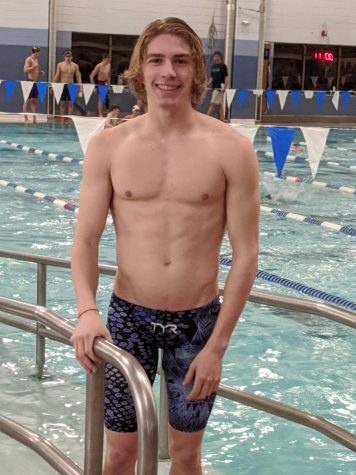
AAHS junior Alex Maline stands in front of the Fort Collins Edora Pool Ice Center (EPIC) pool at the 2020 Senior State club meet. - Thank whoever hosted the pasta party and pick up after yourself.
- Politely holding teammates accountable is good for the team in infinite ways.
- Know your position on the totem pole (the hierarchy of seniority “speed-ority,” and leadership. The food chain if you will.) Respect those above you at all times, they earned it and you will too–with time.
- If your coach wants you to swim an event that you don’t want to swim, do it anyway and give it your best shot.
- Always step up for your teammates as they would for you too.
- Respect the locker rooms and team guidelines.
- Your team is your family! Putting differences aside strengthens bonds.
- Don’t be too self-critical, there is no perfect race, but the pursuit is what swimming is all about.
- You don’t need to know every other swimmer’s times and stats. If you like to read into stats and numbers, you can find a good way to include such knowledge.
- Counting how many total yards a set is and announcing it before the team does it, doesn’t help the team. Instead, try simple positive encouragement to bring up energy and morale. When the tide rises all the boats rise too.
- Swimming is a full-body workout. And is a beacon for foot or leg cramps, induced by AAHS Head Coach Scott Newell’s extensive kick sets. (Hydration and proper stretching alleviates cramps)
- If you lose a fin, keep swimming–you can get the stray fin later.
- When the stopwatch comes out of your coach’s pocket, prepare to go as fast as you can. Your coach will start yelling your times, so listen carefully when you get to the wall.
- Meet warmups are indistinguishable from shark feeding frenzies, and they feel how you’d imagine a feeding frenzy does.
- Challenge yourself every day, no matter how tired you are. Endurance is the only way to make it through swimming, it is hard-earned.

The 2017 AAHS boys’ swim team poses for a photo at their end of the year banquet. - The technique is equally as important as strength is when racing and swimming in general. Do skills and drills right the first time (especially when tired). The longer a bad habit is applied, the harder it is to eradicate.
- You won’t feel solid or motivated every day, and that’s ok. You can only do your best.
- Swimming is 100% a love-hate relationship–with a mostly love bias.
- Grit and ability to assess what you could do better are some of the best qualities a swimmer can have.
- You train for months to swim for a few seconds, make each race the best it can be.
- Mental strength is earned, not necessarily something you immediately have. It is the difference between good and great.
- “You can’t flirt with it, you’ve got to marry it,” were words told to me [Alex] by a longtime friend and mentor. Essentially this means that if you enjoy something and are driven to be better, you will find yourself a lot more immersed than you initially anticipated.
- Have a routine, but don’t depend on it. However, a game plan for every race is something that shouldn’t ever change.
- Talk to your coach before and after every race.
- It’s easy to get into your own head. There’s no single way to not do that, so remember that YOU control your attitude, mental state, and how you respond to the inevitable negative thoughts. So you CAN find a way to change it and it takes practice.
- Going on autopilot during practice is easy, but going on autopilot doesn’t help you get better.
- Your coach will yell and it’s not personal in any way, even though it is sometimes at you. Remember it’s only to help you.
- Everybody has ugly moments at practice, but everyone else is going through the same thing as you, so it’s ok.
- Words of wisdom from Mida: divers aren’t swimmers, carefully pushing their buttons is fun but don’t get rat-tailed with a shammy. Their hot water buckets tantalize the cold swimmers, thus are free game, but in a “capture the flag” way.
- Hard practices can be extremely intense, try not to get rattled.
- Complaining about the current set is 40-60% of the conversations held at the practice.
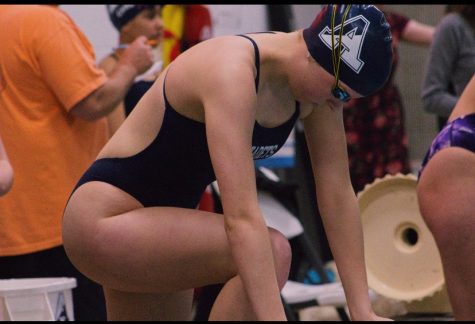
AAHS sophomore Lauren Johnson prepares herself for her race at the AAHS v. DCC meet on January 29th. Photo credit to Elizabeth Dalton. - Don’t be the first or last one in for warmup, and there is no need to sprint it either.
- Go to the bathroom before you put on your race suit, they’re a struggle to get in and out of.
- Wiping or licking the fog out of your goggles ruins them–face the truth.
- It is against USA Swimming rules to dive or jump into a meet warm-up.
- If you make a finals event, know what you’re doing well before you do it and DON’T MISS IT. I [Alex] once got kicked out of a swim meet in Grand Junction on the first day because I missed a finals race.
- Bring multiple towels to swim meets to rotate through, a cold wet towel won’t help you.
- Always have your own swimming equipment, don’t be the “Hey can I borrow your ______?” person.
- Kickboards are not surfboards or frisbees. Kickboards are not surfboards or frisbees! KICKBOARDS ARE NOT SURFBOARDS OR FRISBEES!!!!!!
- Swimmers are always tired.
- Swimmers understand that we smell like chlorine.
- Swimmers can’t smell chlorine after a certain point, all of us are nose blind.
- Swimmers are always hungry, we expend many many calories during practice.
- Chlorine from pools really dries out your skin, so copious amounts of moisturizing lotion saves your skin.
- You don’t need a fresh towel every day after practice, it’s good for a few days as long as it is not too wet. This saves you some laundry.
- Swimmers are sore everywhere, all the time.
- Morning practices can be an emotional rollercoaster, but pretty cool to watch the sunrise while you swim and have a good headstart on the day.
- You don’t need to keep your cap on the whole swim meet, save yourself a headache.

The 2018 AAHS boys’ swim state team pose at their team dinner before the big meet. - Get to your event early, it saves you anxiety and an upset coach or parents.
- As important as making your parents, friends or coaches happy is, make sure you’re at least satisfied–but not really–strive to be better.
- Stop and smell the flowers, meaning appreciate how far you have come, but not for long, there is always more work to be done.
- Remaining positive at all times aids performance.
- Swimming does hurt a lot, but the reward of going fast, beating your competition, and getting good times is worth it.
- Anybody can swim, there is no “built like a swimmer” hard rule.
- Your goggles will leak or fall off from a start at some point or another; don’t quit or panic because of it. Its only water and you will get through it. You can even win your event that way, as I did when I was 12. My very first 400-yard Individual Medley (100 yards of each stroke), my goggles fell off on the start. I ripped them off as I swam and won the heat by 15 seconds. Swimming without goggles toughens you up, it’s good for you. Maybe unless you have contacts in.
- Getting pool water in your eyes or nose only burns initially, it fades quickly.
- When you refer to distance it is in yards (25-yard increments), or meters (typically in increments of 50 meters). They aren’t “laps.”
- Don’t be the swimmer that stops during the set to fix their goggles, fix their cap, re-tie their suit.
- Pro tip from Mida: Just because your goggles CAN fall off, doesn’t mean that they will. So, over tightening them isn’t necessary.
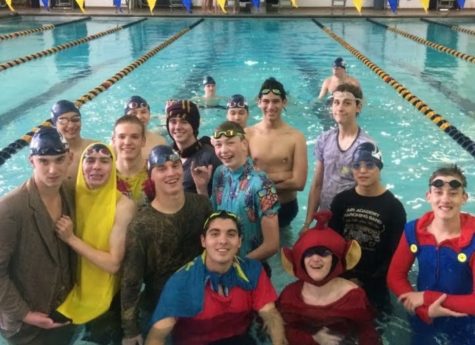
A few members of the AAHS boys’ swim team participating in drag day, a practice where swimmers layer up in order to get an extra work out. - It’s normal to get goggle lines that make it look like we have double black eyes, they do go away and they do not hurt.
- Message from Alex: SPEEDOS ARE NOT WEIRD, so don’t make them weird please; they are not “tighty whiteys,” they are speedos. Contrary to popular belief, they actually aid mobility, as they offer nearly zero movement restrictions, and are quite comfortable. Thus, there is no need to make a big deal about it. The same goes for women’s swimsuits. It’s not cool to shame anyone for what they wear.
- Peeing in the pool is normal, chemicals sanitize it so there’s no need to worry.
- We cannot stress this enough, the floor IS HORRIFYINGLY DISGUSTING, so watch where you step and pick up your trash.
- People’s bodies are what they are, don’t make them self conscious. For some people, it is a big deal to be as vulnerable as a swimsuit makes you.
- Lifehack by Mida: I have eaten three boiled baby potatoes every morning of a meet, carbs are good, potatoes are fantastic. Good breakfast before meets or practice is critical.
- Water polo isn’t as easy as it looks.
- Underwater hockey, underwater rugby, underwater target shooting, and underwater basket weaving do actually exist, among other [ridiculous] water sports. Of course, there are more conventional water sports like diving, scuba diving, rowing, and numerous others if swimming doesn’t pan out for you.
- Most swimmers don’t want to run. Most runners don’t want to swim. The two don’t translate as much as people say.
- Yes, male swimmers shave their legs sometimes, there is no need to make a big deal out of it. Cyclists do the same. We do it to get dead skin cells off and make our skin as smooth as possible to go even faster.
There you have it, some basic rules of being a swimmer. We could write a list that went on and on but the truth is, swimming can be a different experience for anyone who tries it. It may not be the sport for you, or maybe it is what you have been missing your whole life; just remember it is never too late to start. Reach out to coach Newell if swimming is something that interests you, because, in all of our years of swimming, we have never had a more amazing experience than the AAHS swim team.

Howdy!! I'm Alex Maline, and this will be my second year on the Jetstream. This time around I am an editor and I'm excited to see how this year turns out!...

heyo i'm mida (short for parmida), and i hate uppercase letters. i am a senior this year at aahs and this is my second year as part of the jetstream journal...





